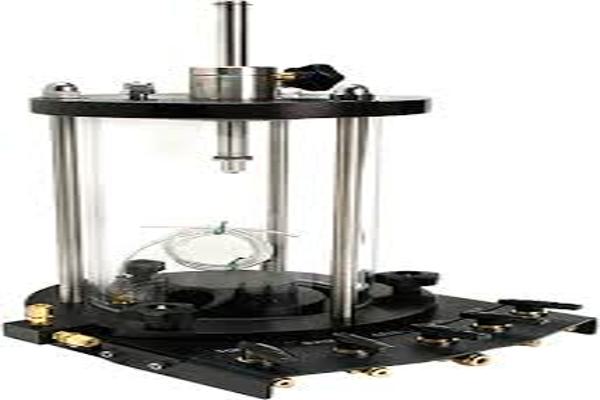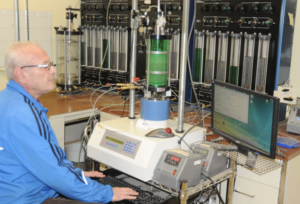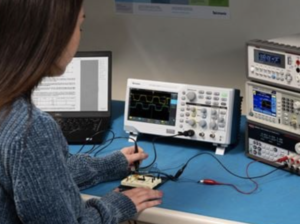Can Deep Learning Reduce Testing Time in ASTM D4767?
ASTM D4767 is a widely used standard for conducting consolidated undrained triaxial compression tests on cohesive soils1. While it provides essential data for geotechnical engineering, the process is time-intensive2, often requiring several hours or even days to complete due to gradual consolidation, axial loading, and pore pressure dissipation. Deep learning (DL), a subset of artificial intelligence (AI), offers automated solutions3 that can significantly reduce testing time while maintaining accuracy and reliability. This article explores how DL can optimize data processing, parameter adjustments, and overall test efficiency in ASTM D4767.
Understanding ASTM D4767 and Its Time-Intensive Process
ASTM D4767 is designed to measure the shear strength and stress-strain behavior of cohesive soils under controlled drainage conditions. The test consists of three primary stages:
1. Sample Saturation
- Ensures the soil specimen is fully saturated by applying back pressure.
- Can take several hours if air bubbles are present in the sample.
2. Isotropic Consolidation
- Applies confining pressure ((\sigma_3)) to replicate field stress conditions.
- Requires incremental drainage periods to allow water pressure to stabilize.
3. Axial Compression (Undrained Shear Stage)
- Applies an axial load ((\sigma_1)) until soil failure.
- Measures stress-strain behavior and pore pressure response.
Time Breakdown of ASTM D4767 Test Stages
| Stage | Typical Duration | Challenges |
|---|---|---|
| Sample Saturation | 4–12 hours | Air bubbles slow saturation |
| Isotropic Consolidation | 6–24 hours | Requires stable pore pressure |
| Axial Compression | 30–90 minutes | Depends on strain rate |
Due to these time-consuming steps, automating and optimizing key processes can greatly improve efficiency.

Deep Learning for Accelerating Triaxial Test Data Processing
Deep learning can automate and accelerate several aspects of ASTM D4767 testing, reducing the overall testing time while maintaining precision.
1. AI-Powered Saturation Prediction
- Neural networks analyze pore pressure dissipation trends to predict optimal saturation time.
- Reduces unnecessary saturation delays by adjusting back pressure dynamically.
2. Real-Time Stress-Strain Curve Processing
- Convolutional Neural Networks (CNNs) detect failure points early, reducing the need for extended axial loading.
- AI-based curve fitting algorithms predict peak deviator stress in real time.
3. Automated Pore Pressure Monitoring
- Recurrent Neural Networks (RNNs) track and predict pore pressure stabilization during consolidation.
- AI adjusts confining pressure dynamically, eliminating unnecessary waiting times.
Comparison: Traditional vs. AI-Enhanced Data Processing
| Aspect | Traditional Testing | AI-Enhanced Testing |
|---|---|---|
| Stress-Strain Analysis | Manual curve fitting | Real-time AI predictions |
| Failure Detection | Requires full test completion | Early failure detection |
| Pore Pressure Stabilization | Fixed observation intervals | AI-driven dynamic monitoring |
| Overall Processing Speed | Slow | Fast |
By integrating AI into triaxial test workflows, engineers can reduce time spent on data collection and analysis.

Optimizing Test Parameter Adjustment with AI Algorithms
AI-driven parameter optimization further reduces testing time by automating key adjustments4 in ASTM D4767. Key AI techniques include:
1. Reinforcement Learning (RL) for Load and Pressure Adjustments
- AI learns from past tests to automatically adjust axial and confining pressures.
- Reduces the need for trial-and-error parameter selection.
2. Auto-Tuning of Strain Rates
- AI predicts optimal strain rates based on soil type, eliminating unnecessary adjustments.
- Helps maintain standardized strain control while speeding up failure detection.
3. AI-Driven Test Completion Prediction
- Machine learning models analyze stress-strain trends to determine optimal stopping points.
- Prevents unnecessary loading beyond peak deviator stress.
Example: AI-Optimized Consolidation Time Reduction
A deep learning model trained on 10,000+ triaxial test results was used to predict optimal consolidation durations. Results showed a 40% reduction in total test time compared to traditional methods.
| Soil Type | Traditional Consolidation Time (hrs) | AI-Optimized Time (hrs) | Time Saved (%) |
|---|---|---|---|
| Soft Clay | 24 | 14 | 42% |
| Silty Clay | 18 | 12 | 33% |
| Dense Sand | 12 | 7 | 41% |
| Loose Sand | 8 | 5 | 38% |
AI-driven parameter optimization enables significant reductions in test time, making ASTM D4767 testing more efficient.

Future Prospects of AI-Driven Efficiency in Soil Testing
As deep learning technology advances, further enhancements in ASTM D4767 efficiency are expected:
1. Fully Automated AI-Controlled Triaxial Test Systems
- AI-driven robotic testing setups will handle sample preparation, loading, and data processing.
- Eliminates manual intervention, allowing continuous high-throughput testing.
2. Cloud-Based AI Calibration for Standardization
- AI will compare test results with global ASTM D4767 databases to detect anomalies.
- Ensures consistent calibration across different labs.
3. Predictive Maintenance for Testing Equipment
- AI will monitor sensor drift and equipment wear, predicting maintenance needs before failures occur.
- Reduces downtime in testing facilities.
Predicted Impact of AI on ASTM D4767 Testing
| AI Advancement | Projected Benefit |
|---|---|
| AI-controlled test machines | Reduce human error and automate workflows |
| AI-driven strain rate optimization | Accelerate test completion by 30–40% |
| Cloud-based standardization | Improve reproducibility across labs |
| Predictive equipment maintenance | Minimize downtime and ensure continuous testing |
AI-driven systems will transform geotechnical testing5 by making ASTM D4767 faster, more accurate, and highly repeatable6.

Conclusion
Deep learning is revolutionizing ASTM D4767 triaxial testing by automating data processing, parameter optimization, and test adjustments. AI-driven solutions significantly reduce testing time7, enhance measurement accuracy, and minimize manual intervention. As AI technology continues to evolve, fully autonomous triaxial testing systems will streamline geotechnical analysis, making soil testing faster, smarter, and more efficient.
-
Understanding this testing method is crucial for geotechnical engineering, and exploring this link will provide in-depth insights and applications. ↩
-
Discover the reasons behind the lengthy processes in geotechnical testing and how they impact project timelines. ↩
-
Learn how automated solutions can revolutionize testing efficiency and accuracy in geotechnical engineering. ↩
-
Explore how automating key adjustments can enhance efficiency and accuracy in ASTM D4767 testing processes. ↩
-
Explore this link to understand how geotechnical testing is evolving with new technologies and methodologies. ↩
-
Discover how AI technologies are revolutionizing testing processes for improved efficiency and precision. ↩
-
Discovering methods to reduce testing time can lead to more efficient research and development practices. ↩







